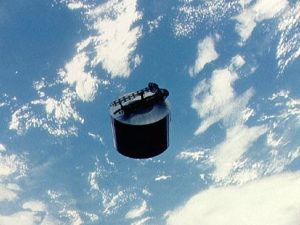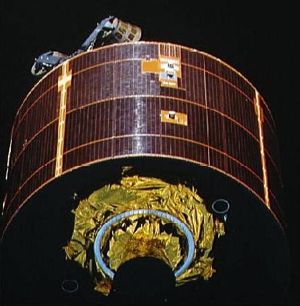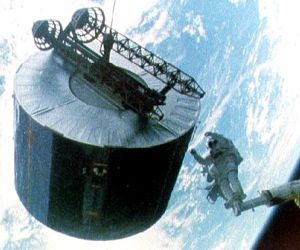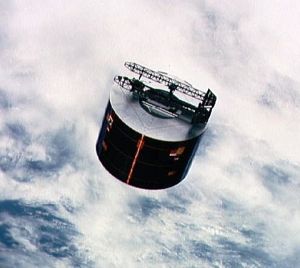
Home - Search - Browse - Alphabetic Index: 0- 1- 2- 3- 4- 5- 6- 7- 8- 9
A- B- C- D- E- F- G- H- I- J- K- L- M- N- O- P- Q- R- S- T- U- V- W- X- Y- Z
Syncom
 Syncom Credit: NASA |
Status: Operational 1963. First Launch: 1963-02-14. Last Launch: 1964-08-19. Number: 3 . Gross mass: 39 kg (85 lb).
More at: Syncom.
Family: Communications technology sat, Geosynchronous orbit, Technology. Country: USA. Engines: Star 13D. Launch Vehicles: Thor, Delta, Thor Delta B, Thor Delta D. Launch Sites: Cape Canaveral, Cape Canaveral LC17B, Cape Canaveral LC17A. Agency: NASA. Bibliography: 2, 279, 4135, 4136, 4137, 4138, 4139, 4140, 4141, 4142, 4143, 4144, 4145, 4146, 4147, 4148, 4149, 6, 6964, 13245.
 | Syncom I; Syncom 1 Credit: Manufacturer Image |
 | STS-41-D Deployment of the Syncom IV (Leasat-2) satellite Credit: NASA |
 | STS-41-D View of the Syncom IV satellite in orbit over the earth Credit: NASA |
 | STS-51-A Syncom IV-1 satellite leaving Discovery's payload bay Credit: NASA |
 | STS-51-D End effector of the Discovery's RMS with tools moves toward Syncom-IV Credit: NASA |
 | STS-51-D Syncom-IV (LEASAT) satellite Credit: NASA |
 | STS-51-I Astronaut James van Hoften on RMS tracking Syncom IV-3 after deployment Credit: NASA |
 | STS-51-I Astronaut James van Hoften working with Syncom IV-3 satellite Credit: NASA |
 | STS-51-I Astronaut James van Hoften working with Syncom IV-3 satellite Credit: NASA |
 | STS-51-I Astronaut James van Hoften working with Syncom IV-3 satellite Credit: NASA |
 | STS-32 SYNCOM IV-5 satellite drifts over cloud-covered Earth after STS-32 deployment Credit: NASA |
1963 February 14 - . 05:35 GMT - . Launch Site: Cape Canaveral. Launch Complex: Cape Canaveral LC17B. LV Family: Thor. Launch Vehicle: Thor Delta B.
- Syncom 1 - .
Payload: Syncom 1. Mass: 39 kg (85 lb). Nation: USA.
Agency: NASA Greenbelt.
Class: Technology.
Type: Communications technology satellite. Spacecraft Bus: HS 301.
Spacecraft: Syncom.
Completed Operations Date: 1963-02-14 . USAF Sat Cat: 553 . COSPAR: 1963-004A. Apogee: 36,739 km (22,828 mi). Perigee: 34,392 km (21,370 mi). Inclination: 33.30 deg. Period: 1,425.50 min.
During firing of the apogee kick motor, contact was lost with the satellite. Syncom (Synchronous Communications) was a NASA project supported by DoD ground stations and communications experiments. Spacecraft engaged in practical applications and uses of space technology such as weather or communication (US Cat C). Four score. Last known longitude (10 March 1987) 172.58 deg E drifting at 2.429 deg E per day.
1963 July 26 - . 14:33 GMT - . Launch Site: Cape Canaveral. Launch Complex: Cape Canaveral LC17A. LV Family: Thor. Launch Vehicle: Thor Delta B.
- Syncom 2 - .
Mass: 39 kg (85 lb). Nation: USA.
Agency: NASA Greenbelt.
Class: Technology.
Type: Communications technology satellite. Spacecraft Bus: HS 301.
Spacecraft: Syncom.
Completed Operations Date: 1969-04-01 . USAF Sat Cat: 634 . COSPAR: 1963-031A. Apogee: 35,891 km (22,301 mi). Perigee: 35,891 km (22,301 mi). Inclination: 32.70 deg. Period: 1,441.50 min.
NASA's Syncom II synchronous communications satellite was placed in orbit by a Thor/Delta launched from Cape Canaveral. Experimental commsat; first geosynchronous satellite. Spacecraft engaged in practical applications and uses of space technology such as weather or communication (US Cat C). Positioned in geosynchronous orbit at 55 deg W in 1963; 26 deg W in 1965. Last known longitude (19 July 1995) 68.47 deg E drifting at 0.089 deg W per day.
1964 August 19 - . 12:15 GMT - . Launch Site: Cape Canaveral. Launch Complex: Cape Canaveral LC17A. LV Family: Thor. Launch Vehicle: Thor Delta D.
- Syncom 3 - .
Payload: Syncom C. Mass: 39 kg (85 lb). Nation: USA.
Agency: NASA Greenbelt.
Class: Technology.
Type: Communications technology satellite. Spacecraft Bus: HS 301.
Spacecraft: Syncom.
Completed Operations Date: 1974-12-29 . USAF Sat Cat: 858 . COSPAR: 1964-047A. Apogee: 35,792 km (22,240 mi). Perigee: 35,784 km (22,235 mi). Inclination: 0.10 deg. Period: 1,436.20 min.
NASA's Syncom III synchronous communications satellite was launched into orbit by a Thrust Augmented Thor/Delta (TAD) launch vehicle in its first use as a space booster. Also carried Star Flash experiment. Spacecraft engaged in practical applications and uses of space technology such as weather or communication (US Cat C). Positioned in geosynchronous orbit at 64 deg W in 1964; 180 deg E in 1964; 25 deg W in 1965; 165 deg E in 1966-1969. Last known longitude (6 December 1974) 6.08 deg W drifting at 0.188 deg W per day.
1964 Sep - .
- Syncom used for military communications with Vietnam. - .
Spacecraft Bus: HS 301.
Spacecraft: Syncom.
The Defense Department began military communications experiments between Saigon, Republic of South Vietnam, and Hawaii using the Syncom II synchronous communications satellite. These Saigon-Hawaii experiments further extended the Defense Department's usage of Syncom II that had begun several months earlier.
1965 January 1 - .
- Syncom 2 and 3 to be transferred to the US Defense Department. - . Spacecraft Bus: HS 301. Spacecraft: Syncom. NASA transferred the operation of Syncom II and Syncom III synchronous communications satellites to the Defense Department which had provided the communications ground stations for the program..
1965 July 8 - .
- Transfer of Syncom 2 and 3 from NASA to the Defense Department completed. - .
Spacecraft Bus: HS 301.
Spacecraft: Syncom.
The transfer of Syncom II and III from NASA to the Defense Department was completed. The Defense Communications Agency (DCA) directed their use, but the Air Force Satellite Control (AFSCF) and its operating locations in the Pacific and Indian Oceans maintained precise control and positioning of the two synchronous communications satellites. The Army and Navy were responsible for the ground communications facilities that were used with the Syncom satellites.
Back to top of page
Home - Search - Browse - Alphabetic Index: 0- 1- 2- 3- 4- 5- 6- 7- 8- 9
A- B- C- D- E- F- G- H- I- J- K- L- M- N- O- P- Q- R- S- T- U- V- W- X- Y- Z
© 1997-2019 Mark Wade - Contact
© / Conditions for Use